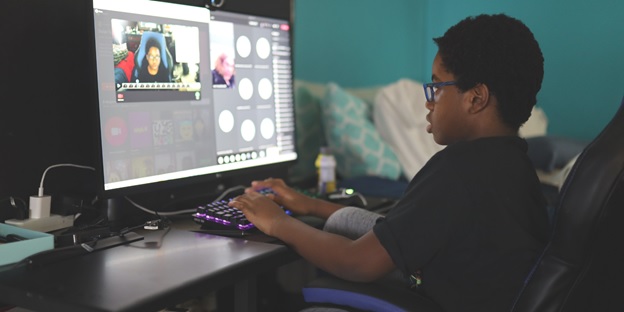Modern challenges require us to look for modern solutions. This phrase has gained particular prominence in recent years. Social distancing and safety measures made us adjust education to the new reality. We learned to communicate and study online, we got used to web conferencing while sitting on a cozy couch at home. However, while each of us realizes the need for online education, not everyone knows about a variety of software tools available for teachers and students. It is even less clear what education software development services are available on the market to create new education tools.
When we think about useful educational tools, the first thing that comes to mind is video conferencing. For sure, this tool enables teachers to conduct lectures, communicate with students in real-time. But what if I tell you that there are many other, no less effective solutions that can be implemented in a classroom? Let’s discuss them in more detail for you to choose the most appropriate ones and get a little closer to the virtual education of your dream. And if you want to dive deeper into the tips and tricks of being an effective virtual teacher, check out our recent article.
1) Online collaborative whiteboards
Communication and education go hand in hand. Students gain knowledge and memorize information while interacting with each other. Teachers have to ensure effective communication even during distance learning. One of the ways to do this is to use online collaborative whiteboards. Online whiteboards work by analogy with traditional, physical whiteboards. They give teachers and students tools to visualize information. Users can add and edit texts, add pictures, highlight important facts. With an online whiteboard, teachers and students can upload additional files and create tables, graphs. They are not limited in space and resources and can freely express their creativity.
2) Digital libraries
Digital libraries are vast databases that can be accessed anywhere and anytime. Digital libraries use technology and information capabilities to allow students for more flexible learning. Usually, a library contains various types of documents. These are magazine and journal articles, books, scholarly papers. Digital library expands this list and includes audio, visual, video information. Having a digital library at a school, educators save students’ waiting time and teach them to process different types of data. Moreover, one source of information can be simultaneously accessed by multiple students. They do not have to manually look for the needed article. All they have to do is to type down a keyword, and the system will automatically look for related sources.
3) Online course banks
Sometimes it happens that a teacher needs to add some practical value to the learned material. To make students more engaged and interested in the learning process, educators should demonstrate how learned material will help learners in real life. One of the best ways to do so during distance learning is to try online courses. Online course banks are platforms that contain a variety of online courses for students of different profiles. Usually, courses present information in an interactive way, testing learners’ performance in the end. Considering the benefits of mobile learning, students get the chance to use their mobile phones to study. So, if you want your students to be more goal-focused, invite them to participate in an online course.
4) Formative assessment apps
Formative assessment apps are more than just tools for getting info about students’ performance. Formative assessment allows teachers to analyze learners’ academic progress and implement the conclusions in practice. Under formative assessment, educators evaluate what students know in the process of learning. Quick tests or quizzes assigned during a lecture will show a teacher whether they move in the right direction. More flexible communication between students and a teacher, more effective and personalized feedback — these are only some of the benefits of such tools. Teachers use formative assessment apps to experiment with the forms of giving instructions and delivering information. In this way, they better understand what memorization techniques suits their learners best.
5) Online teacher communities
Online teacher communities are the supportive spaces where teachers get advice from their colleagues, ask questions, look for the needed sources, make use of someone else’s shared info. An online teacher community is a place where you can learn more about the latest changes in teaching methodologies. This is a space where teachers share their feedback and prevent you from wasting time on ineffective educational solutions. Joining such communities is particularly helpful in the time of the pandemic and social distancing. Online teacher community will give you a better sense of connectedness and increase professional collaboration.
6) Social bookmarking tools
Nearly everyone uses the function of bookmarking available in Internet browsers. It allows students and educators to save, organize, and share information that is useful for their research. This functionality can be even more useful if you use social bookmarking. Social bookmarking allows you to collect and structure information. You can bookmark hyperlinks, collect documents or videos, classify data into categories. This feature comes in handy when your students work on long-term projects or, for example, prepare their diploma papers. The function of highlighting will give them the chance to save useful links and highlight the needed paragraph or sentence.
7) LMS
LMS, or Learning Management System, is a system used for managing all education-related processes in one place. Teachers use LMS software to manage scheduling, get in touch with students, present resources, give homework, and share feedback. With LMS, they can set deadlines and control students’ work, analyze the learning tendencies of a class, interact with colleagues, introduce methodological changes. Students use LMS to manage their learning, subdivide workload into parts. They also access lesson materials, communicate with peers and educators using LMS. Learning management systems save time and effort and facilitate education, particularly when it comes to virtual form. There are different types of school LMS that can be combined into one, customized and powerful solution for your organization.
Concluding Remark
As you see, video conferencing is not the only tool that you can use in your virtual classroom. Modern education technology provides students and teachers with unlimited access to information. It allows everyone to learn, manage, and structure info depending on their goals and needs.

